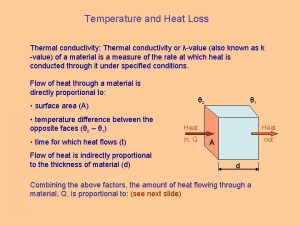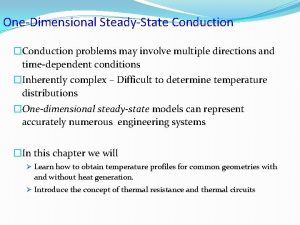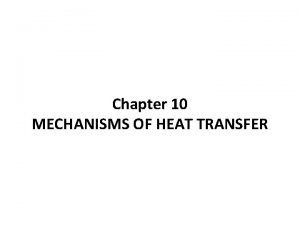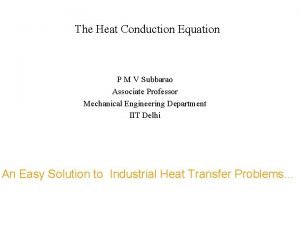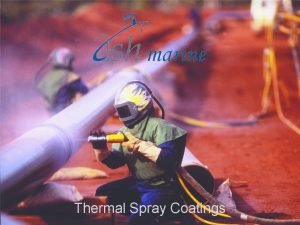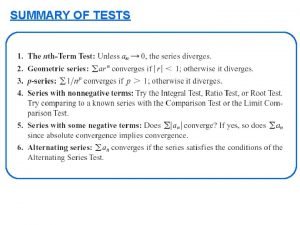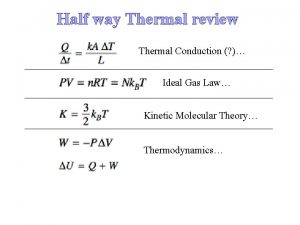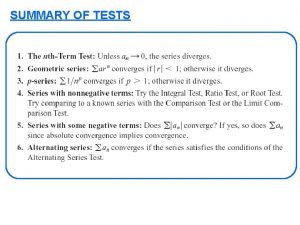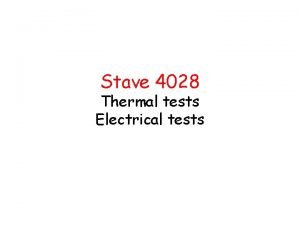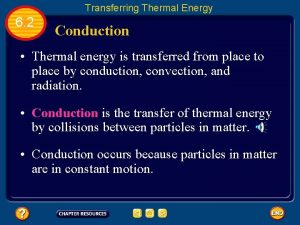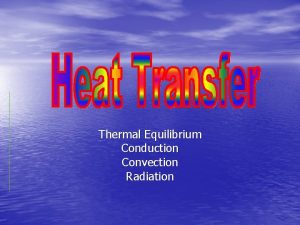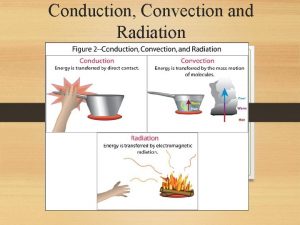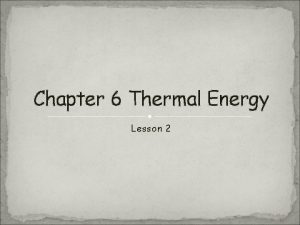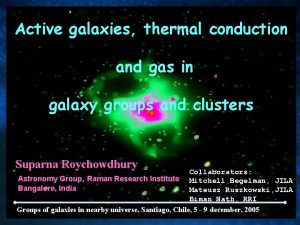Summary of thermal conduction gas tests for ANITA















- Slides: 15

Summary of thermal conduction gas tests for ANITA Goal: To measure the heat transport of different gases in a force-convection condition.

Physical Properties of gases used in this Survey

Bartol Setup The measurements were made using a 14” diameter by 26” long drum with 2 standard indoor / outdoor thermometers to measure temps inside. The drum has two holes for gas exchange and a third for wire feed through.

Setup at Bartol A 2. 6 ohm resistor was placed on a large Al heat sink plate as shown above. The resistor was placed in one of the two large gap between the fins while the temp sensor placed on the other large gap. Another sensor was place on inside surface. The system was mounted on ¼” piece of lucite.

Time profile of the temperature for Nitrogen and Neon/Helium The resistor dissipate 120 Watts on the heatsink and the fans dissipate 6 Watts total (~5% contribution). The dashed lines represent the results with Nitrogen while solid is the Neon/Helium mixture

This plot displays the temperature difference of the heat sink to the ambient (red) and the heat sink to the cylinder surface (black).

Time profile of the temperature differences between the Heat Sink and the cylinder surface which are the dashes lines. The solid lines are the temperature difference between the Heat sink and ambient. The gases tested are Nitrogen, Neon, Sulfur Hex and helium

Relationship between fan electrical current and gas density

d. T= Heat Sink to Room Pr = Cp υ / ρ λ Prandtl number Re = V L / υ Reynolds number d. T= Heat Sink to inside surface υ = viscosity λ = conductivity Cp = Specific Heat Capacity ρ = density V = gas velocity L = characteristic length Simple horizontal flat plate model force convection cooling taken from "Technical Guide to Thermal Processes" by J. Gosse 1986. . This model provides a nice ordering parameter, however our heat sink has a more complicated geometry. The fan current is used solely to correct the internal input heat.

Pr = Cp υ / ρ λ Re = V L / υ υ = viscosity λ = conductivity Cp = Specific Heat Capacity ρ = density V = gas velocity L = characteristic length One method to model an unknown system is to consider the power indices for the Prandtl number and Reynolds as free parameters. Our approached is to adjust the two indices such that the calculated temperature differences (x-axis) are directly proportional to the observed values (y-axis). This was perform by choosing indices which yields the minimum chi-square to a least squares linear fit. The fit is only to data between the heat sink and the cylinder wall in order. This quantity serves as quite adequate ordering parameter Obviously, the heat sink to room temperature difference has an additional transport region to consider (room air to sensor) which is reflected by the offset.

ANITA Compact PCI crate gas Temperature Test at UH Gas inflow and outflow Power, network and sensor cables Compact PCI crate Cardboard Box to thermally isolate PCI crate USB Hard Drive • Testing was done using a compact PCI crate with the same CPU as we are using in flight and 1 Acqiris module (in flight there will be 2 in the crate) • The crate was set on a cardboard box to thermally isolate it and enclosed inside a 55 galloon steel drum (the drum has about ¾ the total volume of the ANITA-LITE pressure vessel). • The steel drum had a removable top which was sealed by use of its retaining ring. Wires were passed through ports drilled into the top of the drum. These ports were sealed with RTV to try and keep the drum as airtight as possible. • The temperature inside the laboratory was monitored as well as three temperatures inside the can – the temperature on the inside wall of the steel drum, the temperature of the air in the steel drum and the temperature of a built in sensor on the Acqiris module. Can Temperature Sensor (T 1) – Not Visible Air Temperature Sensor (T 2)

Nitrogen Gas Test • After about 2 hours the system seemed to stabilize nicely • Acqiris temperature was 44 C which was 10 degrees warmer than the ambient temperature of the Nitrogen inside the can. Argon Test • After ~80 minutes of turn-on Acqiris temperature reached 49 C and the I shutdown the system to avoid stressing the boards. • Argon is probably ~not~ a good gas to use during flight.

Neon Gas Test • After about 3 hours the system seemed to stabilize nicely. • A network problem caused a loss of Acqiris temperature data for about 30 minutes. During this time the computer was unplugged and powered up 3 times. • Acqiris temperature stabilized at about 45 -46 C • Cooling performance is about the same as Nitrogen, perhaps slightly better. Sulfur Hexafluoride Gas Test • After about 3 hours the system seemed to stabilize nicely. • Acqiris temperature stabilized at 41 C. • Cooling performance is better than Nitrogen, the Acqiris boards seems to have stabilized at a temperature 3 degrees cooler than for Nitrogen.

The concept of using gas as an insulator is currently being used in Home Window Industry. As we know Argon makes a great heat insulator and not right choice for our needs. It seems SF 6 is best choice for our flight gas

The Results of the Bartol and UH are consistent qualitatively Our model seems to be able to predict results adequately using choosing an candidate for testing. . In a system where force-convection is the dominate heat flow component, the heat conductivity, heat capacity, density and viscosity of the gas must all be considered in the modeling. Of our survey of gases, SF 6 seems to be the best gas at transporting heat force-convection. .
 Ace different tests iq tests still
Ace different tests iq tests still Thermal conduction resistance
Thermal conduction resistance Critical radius of insulation for cylinder
Critical radius of insulation for cylinder Thermal conduction resistance
Thermal conduction resistance Thermal conduction resistance
Thermal conduction resistance During conduction, thermal energy is transferred
During conduction, thermal energy is transferred Pmv subbarao
Pmv subbarao Buccinador
Buccinador Thermal energy section 3
Thermal energy section 3 Thermal transfer vs direct thermal printing
Thermal transfer vs direct thermal printing Steel gas duct thermal spray
Steel gas duct thermal spray Scholar and gypsy by anita desai summary
Scholar and gypsy by anita desai summary Summary of tests for series
Summary of tests for series Ideal gas vs perfect gas
Ideal gas vs perfect gas Imaginary gas
Imaginary gas Differences between ideal gas and real gas
Differences between ideal gas and real gas

